The City of London was a city of spires, having 107 churches before the Great Fire of London in 1666. 87 churches were destroyed in the fire and 51 were rebuilt by Sir Christopher Wren. Inspired by Wren300, the tercentenary celebration of Sir Christopher Wren (1632-1723), here is our guide to the 51 Wren churches that Wren built, many of which you can still visit today.
Although many Wren churches have been lost, 24 are still intact, including St Paul’s Cathedral and the Friends of the City Churches website will tell you when the churches are open. A mixture of architecture styles, designs by Nicholas Hawksmoor and Robert Hooke and a whole plethora of interesting stories and fixtures and fittings mean these Wren churches are all well worth visiting in their own right. So if you are visiting St Paul’s Cathedral, pop into one of Wren’s other City Churches nearby – we guarantee you will be surprised and delighted by what you find.
1. St Paul’s Cathedral
We start with Wren’s masterpiece – a symbol of London and so iconic that Churchill ordered it must be protected at all cost during the Blitz. The Cathedral took 35 years to build, which was a relatively short timeframe for such a large building, and was completed in 1711 in the reign of Queen Anne. Inside St Paul’s you can see the Great Model, one of the designs for the cathedral based on a Greek Cross which most resembles the final form of the cathedral.
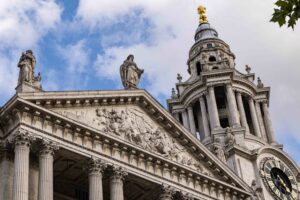
The cathedral is built in Portland stone in the baroque style, complete with lavish stone decoration by the master mason Edward Strong the Elder. The dome stands at almost 365 feet and weighs over 65,000 tons and St Paul’s was the tallest building in London for over 250 years until the BT Tower opened in 1965. Sir Christopher Wren was 79 years old when the building was completed and the last stone of the structure was laid by Christopher Wren Junior and Edward Strong, the Younger, the sons of the men who had dedicated their lives to the building of the cathedral.
The interior was much altered by the Victorians internally, but the exterior is still Wren’s own and is breath-taking from every angle – it is almost impossible to take a bad photo and once you have taken your selfies, have tea in the Crypt, and see the tomb of Sir Christopher Wren himself.
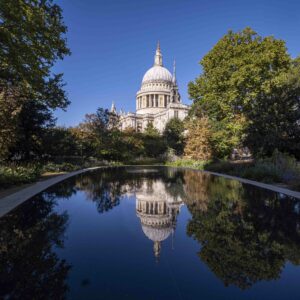
2. St Andrew-by-the-Wardrobe
In deep red edged with contrasting stone, St Andrew-by-the-Wardrobe is a striking Wren church. Its name comes from the Royal Wardrobe, a storehouse for the Crown’s arms and clothing, just to the north of the church until the Great Fire. It was one of the last Wren churches to be restored and above the nave there is a barrel-vaulted ceiling decorated with plasterwork of cherubs and wreaths. William Shakespeare was a former parishioner when he was working in the nearby Blackfriars Theatre and he owned a house in the parish.
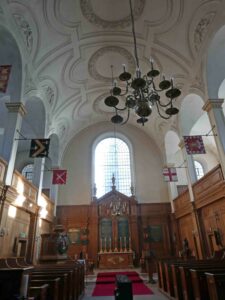
3. St Andrew, Holborn
St Andrew Holborn stands at the western end of the City close to Chancery Lane. It survived the Great Fire of London, but was in such a poor condition that Wren rebuilt it in 1684-1686. The tower is original but was reclad in Portland stone by Wren. It was badly damaged in World War II and finally opened again in 1961. The interior houses the tomb of Thomas Coram founder of the nearby Foundling Museum, and the organ case was donated to that Hospital by Handel, but relocated to this church in the 1960s. It has a lovely garden around the church.
4. St Anne and St Agnes
A church situated off Gresham Street which was destroyed in the Great Fire and rebuilt by Wren in 1680. It is a small brick church based on the Greek Cross a vaulted square within a square. The stonework of the tower dates from the 14th Century. The church itself was badly damaged in World War II, but was restored. It is used by the Lutheran congregation but also today by VOCES8 Foundation. John Milton and John Bunyan were once parishioners.
5. St Benet Paul’s Wharf
This brightly lit, small square church is often overlooked, tucked away near St Paul’s, but is well worth a visit as it is one of the least altered of Wren’s churches. The church was originally on the river (pre widening of the embankment) where they were unloading material to build the cathedral, hence the second part of the name, and the first part is an abbreviation of St Benedict (the old spelling was St Bene’t). The services each Sunday are in Welsh.
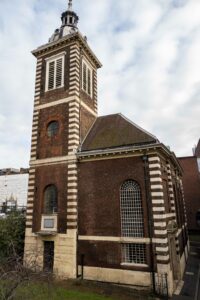
6. St Bride Fleet Street
Situated just off Fleet St, St Bride’s – named after the 5th century Irish nun St Bridget – is most famous for its ‘wedding cake’ spire, which at 226 ft makes it the tallest Wren church in the city. Known as The Journalists’ Church, its association with the printed word dates back to 1500 when Wynkyn de Worde set up a printing press next door. The church was gutted by incendiary bombs in 1940 and the resulting restoration works that followed revealed the remains of Saxon and medieval churches on the site as well as a Roman villa.
@sixinthecityldn Do you know this alley? #sixinthecityldn #visitlondon #secretlondon #mylondon #fyp #church #weddingcake #irish #saints #wren #hiddenlondon
7. St Clement Eastcheap
No longer quite on Eastcheap, (due to new roads) this is the ‘Oranges and Lemons’ church of the nursery rhyme, (although another cheeky upstart church also claims this) and one rather ‘improved’ by the Victorians. There is still fine woodwork to admire, but the church has been put to good use as the home to the human rights charity Amos Trust and two other charities, so the pews have been removed.
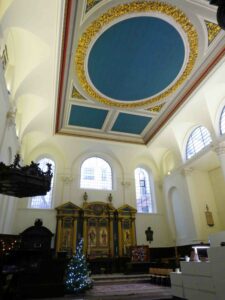
8. St Edmund, King and Martyr
St Edmund was the king of East Anglia in 855 and was the patron saint of England before being superseded by St George. The present church of St Edmund, King and Martyr, a Grade 1 listed building, has been attributed to Sir Christopher Wren and Robert Hooke, and was built in 1670-79 on the site of a former medieval church. This medieval church is believed to have been located on the western edge of a Roman Basilica and it is therefore likely that there are significant Roman archaeological remains below ground. Do look upwards too at the tower ornamented at the angles by flaming urns, a nod to the Great Fire. The church is not universally admired, and many consider it ‘’Wren’s Worse Church”. Even Christopher Wren Junior criticized the “unpleasing openness in the arches of the lanthorn”. Now it is a centre for Spirituality and its pews have been removed and replaced with bookshelves.
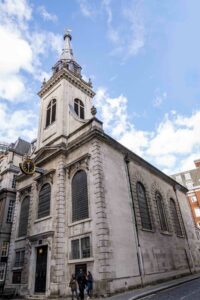
9. St James Garlickhythe
St James Garlickhythe is often referred to as Wren’s Lantern as it is so full of light, and the ceiling is the highest of the Wren churches after St Paul’s Cathedral. It is thought there has been a church on this site since Anglo Saxons times and the nearby Vintners paid for its refurbishment in the fourteenth century. It’s seen some adventures: a Zeppelin bomb narrowly missed the church during the Great War; death watch beetle nearly destroyed the roof; one of its rectors was burned at the stake at Smithfield and a crane toppled cover and crashed into the north wall. There are plenty of treasures to admire in this beautiful church, including the baptismal font and altar table.
10. St Lawrence Jewry
The official church of the City of London Corporation, St Lawrence Jewry is named after its location near the medieval Jewish enclave of Old Jewry. Originally surrounded by other buildings, only the elaborately classical east wall faced the public reflecting its importance on the site. Gutted by bombing in 1940 it was beautifully restored in the 1950s – the spire is a glass fibre copy of the original – and is just emerging from extensive recent restoration looking shiny and new.
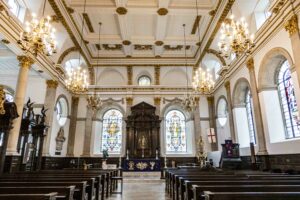
11. St Magnus the Martyr
Just down the road from the Monument, for centuries St Magnus the Martyr stood at the entrance to the old London Bridge (when that was rebuilt in 1823 it moved up the road by a few 100 feet to its current location). One of the first things you notice is its wonderful 18th century clock facing up the hill, but the outside also boasts a Roman pillar of wood, and inside is a wonderful model of the old London Bridge, complete with shops and chapel.
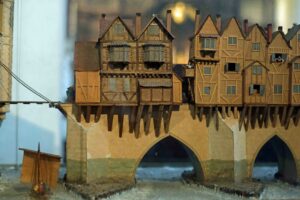
12. St Mary Abchurch
Situated in a courtyard behind busy Cannon Street, the small St Mary Abchurch has a tardislike quality, thanks to Wren’s use of a domed ceiling (painted by parishioner William Snow) which gives the illusion of space within. The magnificent limewood reredos in this Wren church was created by master carver Grinling Gibbons.
13. St Mary Aldermary
A rare example of a Wren church in the Gothic style, St Mary Aldermary has one of the finest 17th Century Gothic towers in the country. The fan vaulted plaster ceiling in the nave and aisles is by Henry Doogood, one of Wren’s most talented craftsmen. The church is also home to one of only two wooden sword rests in the City churches (a sword rest is where the Lord Mayor of London places his ceremonial sword when visiting a City church). There is a café in this church and you can “work from a CHURCH” if you book a table.
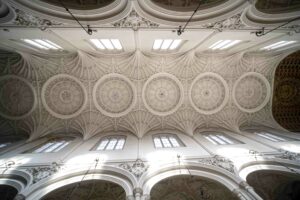
14. St Mary-at-Hill
St Mary at Hill is one of Wren’s Square churches. John Betjeman admired the church and said It had the ‘least spoiled and the most gorgeous interior in the City’. It is however a rather surprisingly empty space- – perhaps a result of many fires and subsequent restorations. Inside the body of the church is pleasingly airy, with a barrel-vault in a Greek cross plan and central dome, resting on free-standing Corinthian columns, which rises above the flat ceiling. It sits on Lovat Lane- a gloriously meandering, narrow and cobbled road that makes its way downhill towards the Thames.
15. St Mary-le-Bow
The tower and steeple of St Mary-le-Bow, with its 9ft copper dragon weathervane, dominate Cheapside. Wren discovered the Norman crypt and a Roman roadway when building the tower and it is believed to be named after the arches in the Noman crypt beneath the church (bow is an old name for arches). The “great bell of Bow” features in the “Oranges and Lemons” nursery rhyme, as well as calling Dick Whittington back to London.
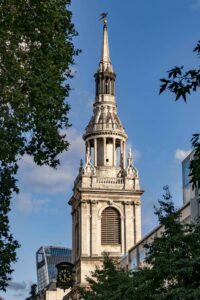
16. St Margaret Lothbury
Often referred to as the bankers church situated as it is behind the Bank of England on Lothbury Street. It was restored by Christopher Wren between 1682-1693 with the 5-storey tower attributed to Robert Hooke, but at a later date. St Margaret Lothbury is a small church but much of its interior consists of items from churches that disappeared from the city in the Victorian era.
17. St Margaret Pattens
A gem of a Wren church in East Cheapside, St Margaret Pattens was rebuilt by Wren in 1687, both simple and splendid at the same time. The spire was the 3rd tallest in the city at 200ft high and the only one restored to a medieval style. The interior has some of the only canopied pews found in a Wren church. The word ‘patten’ refers to the wooded clogs that people used to wear to keep out of the dirt of the streets, which were made by artisans in the nearby area and examples can be seen in a display cabinet in the church. There is some graffiti in the church – with CW carved into a pew – some say it stands for Christopher Wren but others say it possibly means Church Warden.
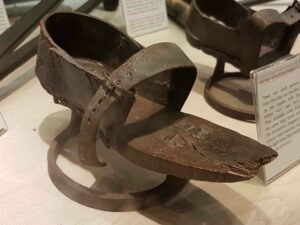
18. St Martin, Ludgate
As you look up Ludgate Hill towards St Paul’s, St Martin Ludgate stands on the left – its tall spiky spire designed by Wren as a counterpoint to the great cathedral dome. Situated just inside the city gate, it’s one of the few Wren churches to have survived WW2 intact. In fact, the remains of the old Roman wall are incorporated into the west wall of the church.
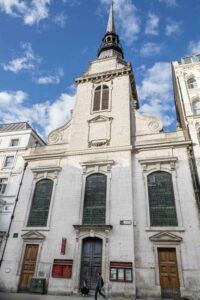
19. St Michael Cornhill
St Michael’s is traditionally considered a Wren church and the upper part of the tower was designed by Nicholas Hawksmoor in the 18th Century. Remodelled and Victorianised by George Gilbert Scott in 1857-60. The churchyard has been turned into a garden and it is next to Jamaica Wine House, where the Pasqua Rosee Coffee House, London’s first coffee stall, was established in 1652.
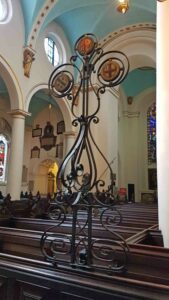
20. St Michael Paternoster Royal
A good example of a Wren church with an original 17th Century tower and steeple. The three-stage steeple is similar to those of St Stephen Walbrook and St James Garlickhythe. Famous as the church of Richard Whittington, four times Lord Mayor of London. It was the Headquarters of the Mission to Seafarers, a charity supporting those who work at sea, until 2022.
@sixinthecityldn London Churches. #didyouknow #londonfacts #fyp #sixinthecityldn #visitlondon #fountains #londonguide #hiddengems #secretlondon
21. St Nicholas Cole Abbey
St Nicholas Cole Abbey is dedicated to St Nicholas, the patron saint of children who brings presents on 6 December and the “Cole Abbey” is probably a corruption of “Cold Harbour” – a medieval shelter for travellers. The Wren church has an unusual trumpet shaped steeple with a weathervane from St Michael Queenhythe. Inside, modern additions are stained glass windows designed by Keith New who designed the windows for Coventry Cathedral.
22. St Peter upon Cornhill
One of the oldest churches in the City of London, St Peter upon Cornhill stands on the highest point in the City, on the site of the Roman basilica. Wren’s church has an elaborate classical stone façade on Gracechurch street and a good view of the brick tower can be seen from the churchyard at the back. The churchyard is mentioned in Dickens’ Our Mutual Friend and is where Headstone proposes to Lizzie Hexham, much to her alarm (the 1998 BBC adaptation is highly recommended). The church was also the original home to The Players of St Peter who put on medieval mystery plays every year.
23. St Stephen Walbrook
Simply a ‘must see’ even if you have only the slightest interest in Wren. St Stephen Walkbrook is a stunning light filled, clear glass windowed, almost white interior church. Initially deceptively simple, the numerous geometric shapes in the structure reveal Wren to have been the mathematician he was. The dome was a forerunner of St Paul’s, and the later addition of the Henry Moore travertine marble altar is still dividing opinion!
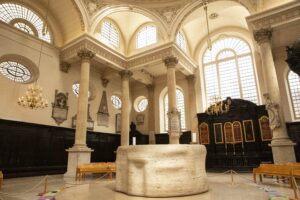
24. St Vedast alias Foster
Within the shadow of St Paul’s Cathedral is the lovely St Vedast alias Foster which has an elaborate Baroque steeple, attributed to Nicholas Hawksmoor and built by Edward Strong the Younger. Inside, the Wren church has many original 17th century furnishings, mainly from other churches and a modern gold and silver leaf decorated ceiling which was added after World War II left the church without a roof. The most delightful part of the church, however, is leafy Fountain Court next door which has a wonderful collection of weird and wonderful artefacts including a Roman road and a piece of an Assyrian ziggurat found by Max Mallowan, an archaeologist and Agatha Christie’s second husband.
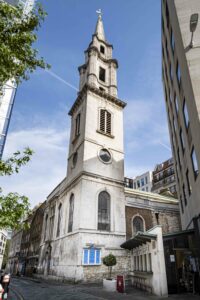
Part 2 will explore the Wren churches that have been lost or have found a second secular life.
If you’re interested in seeing Wren’s churches, come on one of our walks celebrating Wren300 which run monthly from April to August.
Authors: Caroline Powell, Courtney Plank, Freda Dahl Nielsen, Jane Copland and Ildiko Bita
